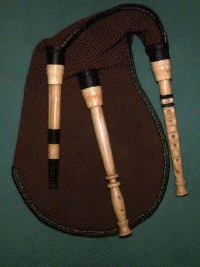"Sweden's bagpipe usually only has a single drone, a sure sign of its great age and also an indication of good taste. For, how any melody could sound well, to the constant accompaniment not only of the keynote but also the low third, that is beyond our understanding."
C.A. Mankell 1853.

Bagpipe by Bengt Sundberg
Swedish bagpipes have their closest relatives in some East European bagpipes. They are mouth blown and have one free standing drone, across the piper's chest. Single reeds are used in both the drone and in the chanter, and both bores are cylindrical (6 mm). The pipes have a 'reedy' but reasonably quiet sound, comparable to a harmonica in tone and to a forcefully played violin in volume. Here is a sound example: Shepherds call from Lima (in Dalarna, not Peru!).
The basic Swedish bagpipe chanter has 6 finger holes and one hole for the top hand thumb. This is consistent with the preserved instruments from the past. The scale is an A-minor scale with the key note in the middle, ranging from e' to e''.

( Click the image to hear the scale)
|
A commercial retailer of Swedish bagpipes in the USA describes this scale as "the haunting Swedish scale". Indeed, in the key of E this scale would be unusual, also to a Swede, but the basic chanter is almost always played in A-minor. In that key the scale becomes less exotic, being the simplest possible minor scale - an A-major scale with a flat third.
The drone is most often tuned to e', retunable to d' by covering a tuning hole, but drones in a or e (an octave below the chanter's low e') are also common.
Reeds
The single reeds used in both the chanter and the drone are traditionally made from the only native reed useful for this purpose, Phragmites australis. However, Phragmites is very sensitive to humidity, so today it is common to use imported continental reed instead (Arundo donax) - the material used in most other reed instruments.
Single reeds are made by slicing a vibrating "tongue" from the straw, as in the picture. The reed to the left is made from Phragmites australis, the one to the right is made from Arundo donax. Note that the tongue can be cut both ways. See the section on Reed making for details.
|




